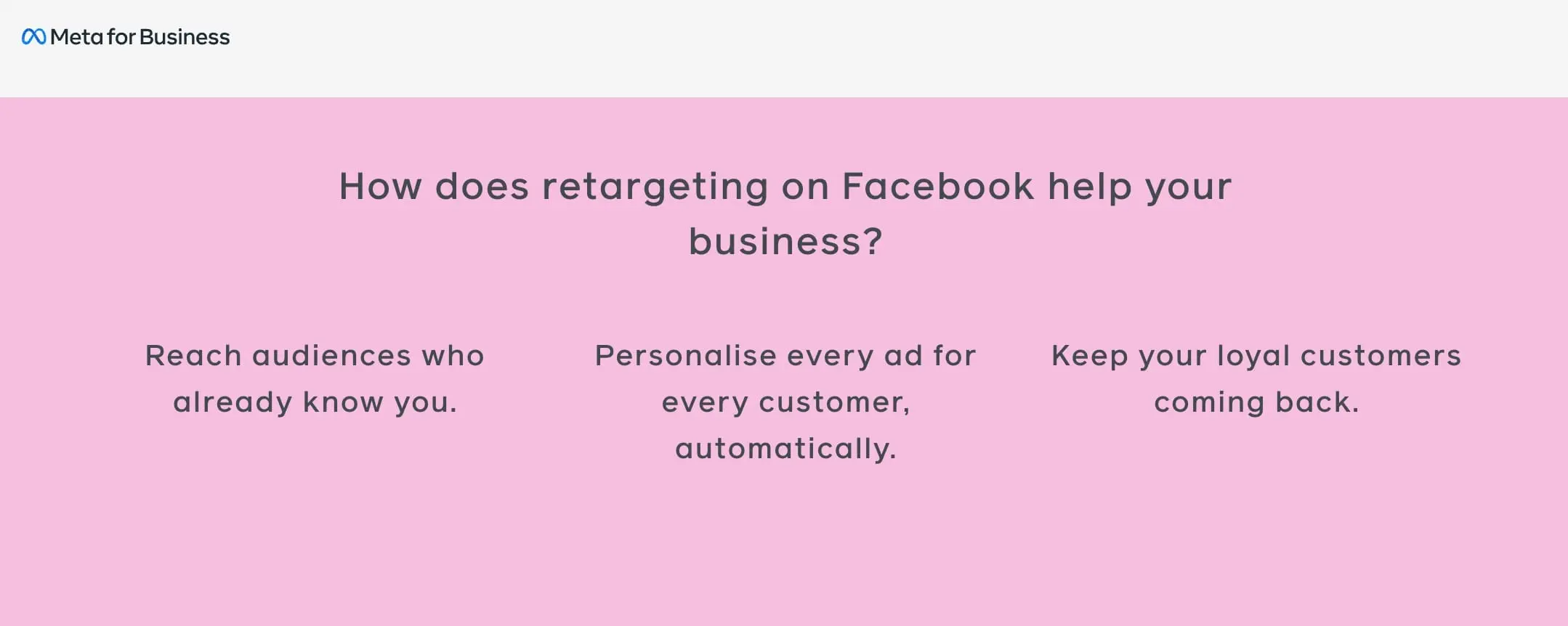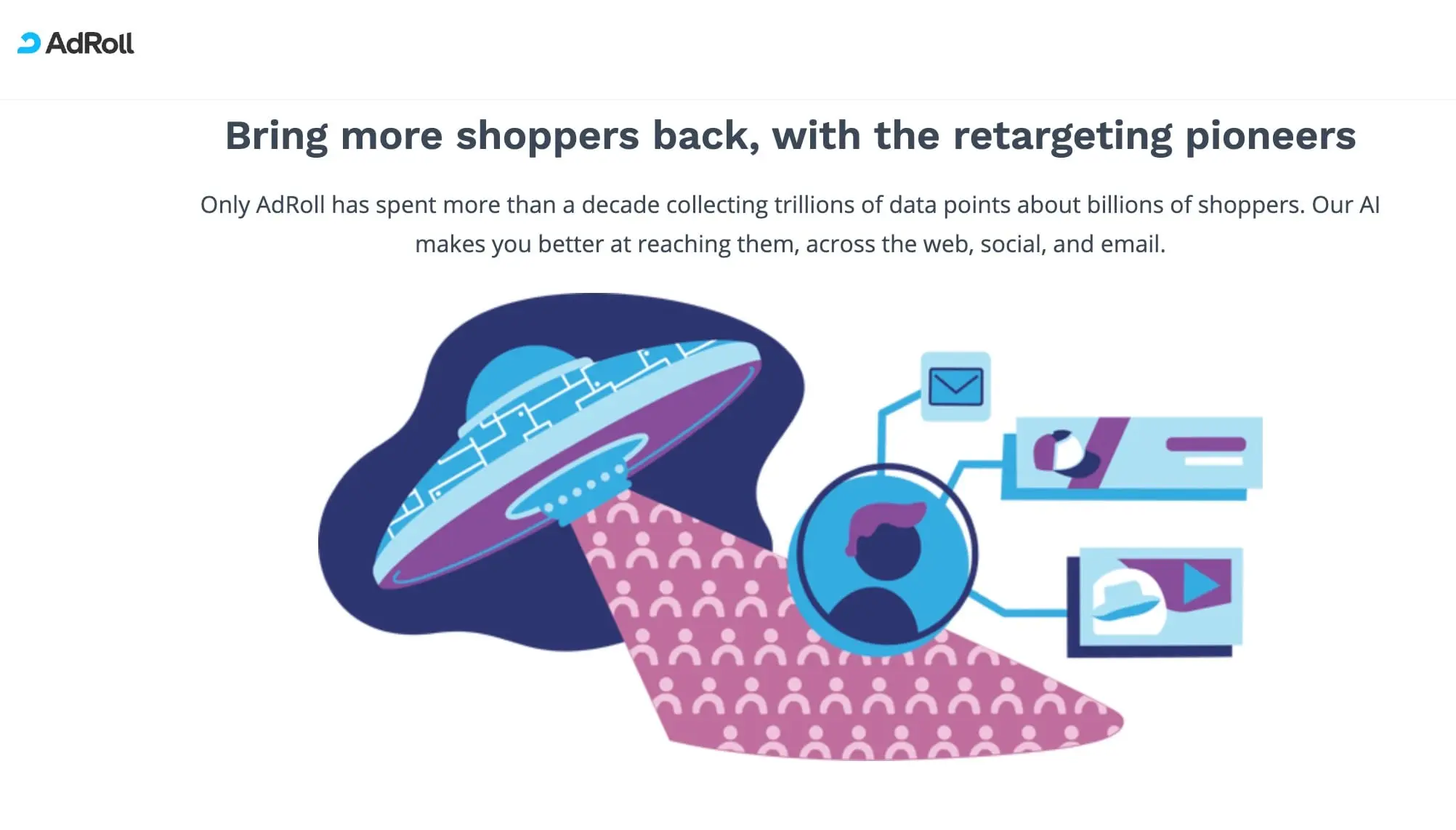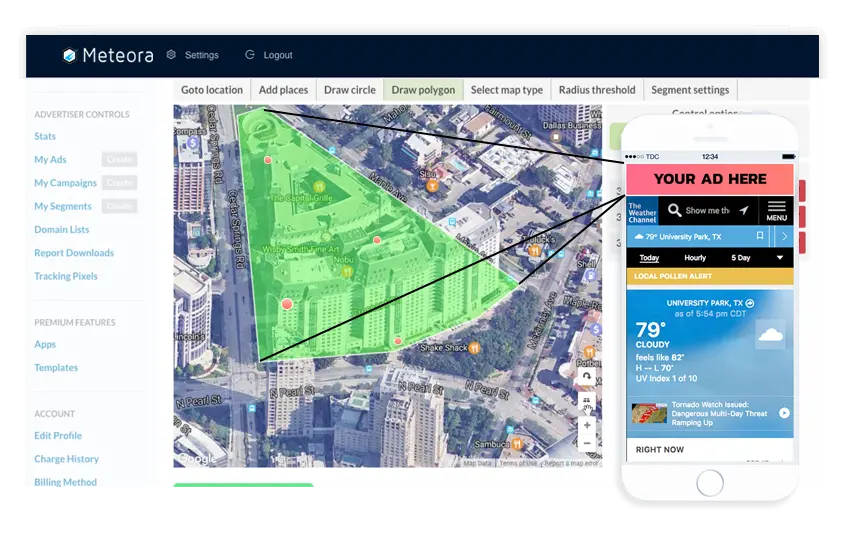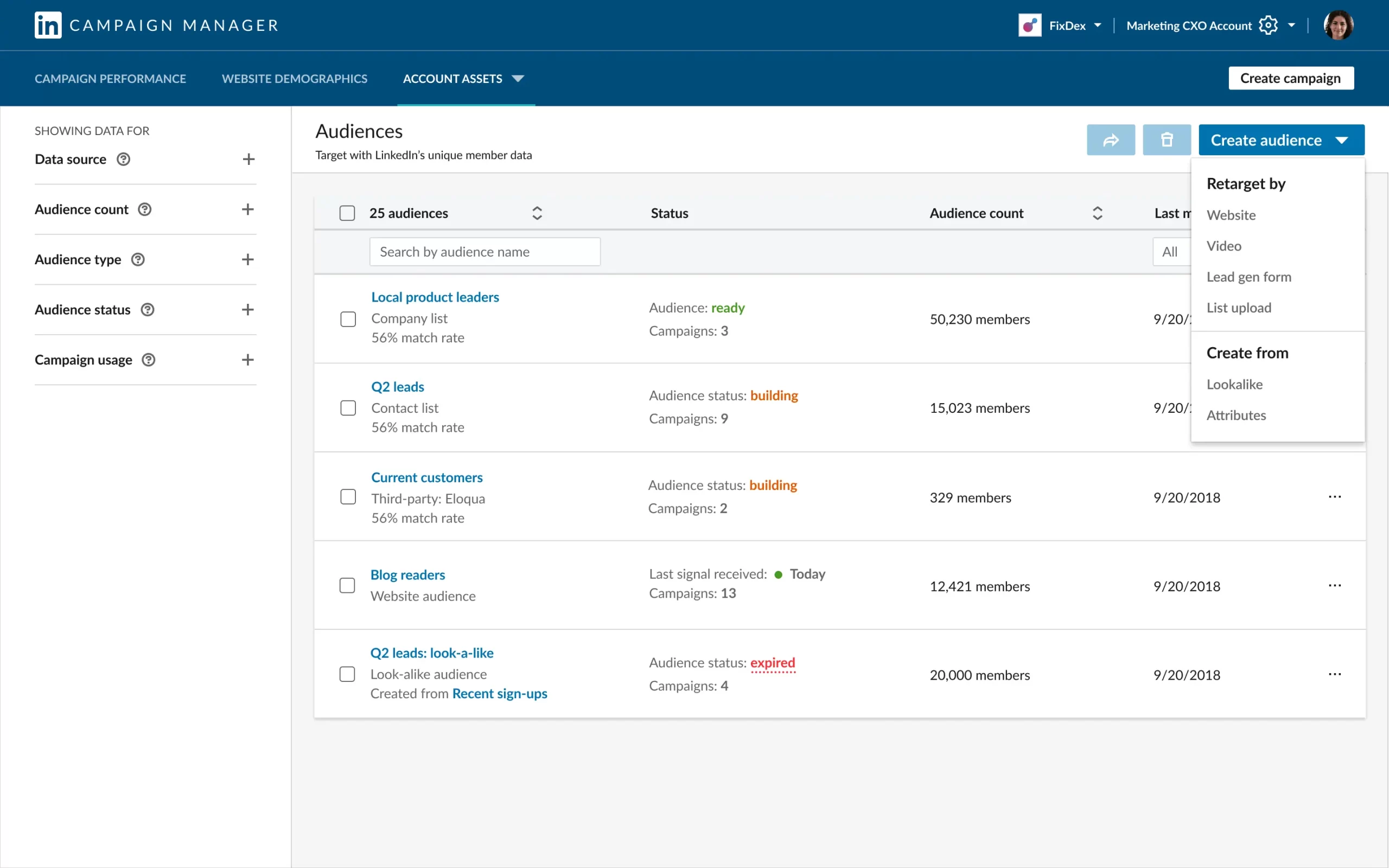Retargeting platforms give companies a second chance at converting a customer when an initial interaction doesn’t produce a sale.
With a retargeting network, you can remind your customers why they visited your site and considered your products in the first place, and nudge each prospect further down the sales funnel.
To help you get the best results from your retargeting campaigns, we’ve reviewed some of the top ad retargeting solutions on the market, to bring you our best picks.
Top 7 Best Retargeting Platforms
| Platform | Main Features |
|---|---|
| 1. Facebook Ads | Retargeting on Facebook, Instagram, What’s App, and Messenger. |
| 2. Google Ads | Remarketing on Google Search, YouTube, Google Discover, Gmail, and Google Partner sites. |
| 3. Adroll | Remarketing with ads and email on all major platforms. |
| 4. MailChimp | Email remarketing. |
| 5. Criteo | Reach users on high-quality websites with video and text ads. |
| 6. Meteora | Local and geo-retargeting. |
| 7. LinkedIn Ads | B2B retargeting on the LinkedIn network. |
1. Facebook Ads

Facebook retargeting is one of the most popular options for reconnecting with customers today. With billions of monthly active users, Facebook reaches a huge number of potential leads.
The Facebook Ad Network is also responsible for advertising via WhatsApp and Instagram.
Facebook retargeting allows companies to personalize ads on a granular scale, with dynamic content to ensure you deliver the most relevant messages to your prospects.
How does Facebook retargeting work?
Facebook retargeting is a relatively straightforward process. You start by creating a list of people you want to retarget. You can do this by uploading information from your CRM or using an existing audience you have on Facebook.
Next, you install the Facebook pixel (a snippet of code) into your website to track the people who visit your website from Facebook and the kind of actions they take. This allows you to collect information about each customer, such as the sites they visit, and the items they add to their shopping cart.
Your Facebook pixel automatically adds people who visit your website to your Custom Audience (the audience you’re targeting) on Facebook, based on specific actions – like people who view a product and don’t make a purchase.
Once you have your audience, you can choose the kind of ad you want to create. Dynamic ads allow you to automatically show each customer the most relevant products to them based on what they’ve done on your website. Static ads simply deliver the same content to everyone in a specific group.
Our Retargeting Course will show you step-by-step how to run retargeting campaigns on Facebook.
Are Facebook Ads retargeting worth it?
Facebook Ads allow you to reconnect with specific audiences through multiple platforms in the Facebook ecosystem – including Facebook, Instagram, and Messenger.
With custom audiences and the Facebook Pixel, you can specifically target customers who already have an interest in your website or products.
As an extra bonus, the Facebook analytics tools can help you track what kind of ads and platforms are getting the most attention with your remarketing campaigns. With Facebook retargeting, you can:
- Design and deliver highly specific campaigns to relevant groups.
- Create dynamic ads which adapt to your audience.
- Reach your audience via Facebook feeds and Messenger.
- Track performance through in-depth insights.
Start With Facebook Retargeting
2. Google Ads

Alongside Facebook ads, Google remarketing ads are among the most popular way to reconnect with visitors.
A Google retargeting campaign allows you to position your ads in front of your audience not just when they’re browsing the Google network, but also when they’re visiting partner websites.
With Google retargeting ads, you can make sure your content shows up when people are searching for products similar to yours online. You’ll also be able to create comprehensive customized campaigns, tailored to your audience’s preferences.
How do Google Ads retargeting work?
Similar to other top ad retargeting companies, Google uses a piece of dedicated code to track which people visit your website.
You’ll need to install this pixel within your website so you can collect information about customers on your website and create custom lists of people to target.
There are a number of “campaign types” for retargeting ads on Google, including
- Standard retargeting ads: Campaigns that show the same ad to past visitors as they browse apps and sites within the Google Partner Network.
- Dynamic remarketing: Dynamic retargeting allows you to dynamically adapt each ad to show the products or services other people viewed on your website.
Google also allows you to place your retargeting ads within the search engine results pages (SERPs) when people are doing follow-up searches for the products they need or show ads to people browsing videos on YouTube.
Interestingly, Google gives users a lot of control when it comes to choosing how and when the retargeting ads are shown.
You can optimize your retargeting lists to focus on people who visited specific pages of your website. You can also ask Google to exclude your retargeting ads from any website pages associated with specific topics.
Is Google Ads retargeting worth it?
Google’s advertising tools are some of the most reliable in the world. They’ve been around for almost as long as the search engine itself and remain among the most popular choices for business leaders and marketers trying to stand out online.
Google Ads retargeting campaigns are particularly impressive because they’re so customizable. You can set specific budgets according to your business needs, get extremely granular with your target audience, and decide which triggers should launch a retargeting campaign.
Google Ads even allows you to control where your ads show up in its vast network, ensuring you can avoid association with the wrong websites. Some of the biggest benefits of Google retargeting include:
- Retarget on all Google assets, including the partner network, and the SERPs.
- Customize where your ads show up to protect your reputation.
- Set a budget that works for your brand.
- Choose specific results for advanced campaigns. (Like getting more phone calls)
Start with Google Ads Retargeting
3. Adroll

Adroll is a popular retargeting platform designed to help companies improve their online presence.
The platform comes with access to a wide range of retargeting tools, intended to recapture audience attention and achieve more conversions.
Adroll offers turnkey integration with the top eCommerce platforms, making it easy to collect information about your audience.
How does Adroll retargeting work?
Like most retargeting platforms, Adroll works by placing a small piece of code on your website to collect information about your users.
Using an AI algorithm, the system then reviews and analyzes millions of customer touchpoints, to target users with relevant content across 500 ad networks.
You can target shoppers across various channels and devices, creating customized campaigns specific to each customer.
Adroll supports a range of retargeting options, including
- Contextual targeting: Which showcases your brand alongside the content you want your company to be associated with.
- Demographic targeting: Identify your ideal customer and find similar customers by targeting attributes like gender, age, and net worth.
- Behavioral targeting: Define your target audience to help understand where they’re likely to go when leaving your website, then show them ads based on previous products viewed.
With Adroll, companies can create both static retargeting messages, or dynamic retargeting campaigns, which serve up highly personalized content based on what your customer has done when interacting with your site in the past.
The ad-building platform is easy to use, and Adroll’s vast publisher network integrations include connections with major platforms like Google Ads, Instagram, Facebook, and Linkedin.
Is Adroll worth it?
Adroll offers a convenient, centralized platform, where companies can create customized and highly personalized retargeting campaigns.
The Adroll AI algorithm helps to capture useful information about your target audience to determine where you should show your ads to get the best results.
AdRoll’s personalization tools also follow users across multiple marketing channels, devices, and browsers, so you can reach your audience wherever you are.
With a thirty-day free trial, it’s also surprisingly easy to get an insight into how the technology works.
4. MailChimp

If you’re already using email in your digital marketing strategies, using a solution like Mailchimp retargeting makes a lot of sense. Best-known for its feature-rich environment and easy-to-use interface, Mailchimp is a popular email marketing and retargeting tool in the online world.
Because Mailchimp is one of the leaders in email marketing, it’s well-positioned to help companies build meaningful retargeting campaigns based on large amounts of customer behavioral data and segmentation information.
How does MailChimp retargeting work?
After connecting your eCommerce store to MailChimp through the various integrations offered by the tool, you can begin collecting information about visitors.
The Mailchimp system will collect information about people who visit your site, focusing specifically on subscribed contacts who have already shared their email addresses with you.
By focusing on people who have already agreed to share their details with your company, you can get as granular as you like with your retargeting campaigns on MailChimp.
The system allows companies to build segments based on how audiences have engaged with a website, app, or email campaign.
You can also choose exactly how long to wait before connecting with a customer about an item left in their basket. MailChimp allows users to set comprehensive retargeting rules, and design either static or dynamic emails, based on their needs.
The easy-to-use, drag-and-drop email designer allows users to add dynamic segments which can change to show the product a customer recently viewed or added to their basket.
Is MailChimp retargeting worth it?
The Mailchimp retargeting platform takes a slightly different approach to remarketing than some of the other platforms mentioned on this list. Rather than serving ads across a network of websites, it allows you to send reminder messages to customers who have already subscribed to your email list, to help draw them back to your website.
Email is the third most popular form of retargeting after Facebook and Google remarketing campaigns.
It’s also a great option if you’re trying to build and nurture relationships with customers over time. MailChimp’s in-built analytics will allow you to develop a deeper knowledge of your audience.
Start with MailChimp Retargeting
5. Criteo

A dedicated PPC advertising platform and retargeting solution, Criteo promises a massive return on ad spend for customers using its state-of-the-art dynamic retargeting solution.
The platform helps companies to understand their target audience and present retargeting ads on the right channels, based on machine learning and AI algorithms.
The Criteo platform is particularly popular among marketers because of its extensive dynamic capabilities and customizations. You can also show your ads with some of the world’s top publishers in the Criteo open network.
How does Criteo retargeting work?
Similar to many of the best retargeting companies, Criteo enables remarketing campaigns by placing a piece of custom code on your site. This code allows the unique Criteo AI engine to see the engagement of shoppers on your website and power specific product recommendations via dynamic ads. This means you only show your customers products they’ve seen in the past.
Criteo can dynamically generate not just visual ads and text, but video ads for every shopper, featuring items they might be interested in based on browsing history, or items they’ve viewed before.
The machine learning system utilizes extensive customer data to improve your chances of maximizing your budget and bringing more people back to your store.
You can set bids on the Criteo retargeting platform based on the value of each customer to your brand, and predictive bidding technology shows you the potential ROAS for each customer.
Criteo retargeting campaigns can spread across websites in the partner network, as well as Facebook and Instagram.
Is Criteo retargeting worth it?
Criteo retargeting ads allow companies to reach shoppers on a range of channels, with a variety of different dynamic campaigns. You can retarget shoppers with personal videos and seamlessly connect with customers across multiple apps, websites, and screens.
The machine learning technology built into Criteo is particularly impressive, as it helps business users to personalize each element of their ads, and craft experiences for converting more shoppers.
The machine-learning technology continuously works to improve the performance of each campaign on your behalf. You can even get suggestions to show shoppers products they haven’t seen yet.
6. Meteora

Focusing heavily on the concept of “local” retargeting, Meteora is a compelling retargeting tool designed to help brands target customers based on the stores and locations they visit.
With this technology, businesses can build their retargeting campaigns around specific locations using geofencing. This means you can actively focus on drawing more traffic to specific real-world places.
Dozens of well-known brands are already utilizing Meteora as a solution for driving foot traffic and local sales, including Sonic Automotive, and McDonalds.
How does Meteora Work?
The idea of “geo-targeting” your customers with your retargeting efforts might sound complex at first, but Meteora strives to make the process as simple as possible.
There are step-by-step videos and articles to guide you, but essentially it all boils down to three steps:
- Targeting: Companies can draw unlimited geofences around locations in the real world most likely to see foot traffic from your target customers. For instance, you can pinpoint areas where your competitors are.
- Augment: After choosing your geofence areas, you can layer on frequency, IP targets, IDFA lists, geography, and third-party data segments, for even more advanced targeting.
- Measure and optimize: Meteora provides state-of-the-art analytics to show you how well your campaigns ran with in-depth accuracy. You can break down reports according to everything from domain or app, to device, campaigns, and more.
Is Meteora Worth it?
Meteora’s unique location-focused methodology makes it easier to pinpoint exactly what kind of customers you want to pull back to your website with your retargeting campaigns.
Geofencing location data analysis tools help you to achieve more accuracy with your approach to reaching potential leads and converting them into loyal consumers.
The high-quality reports and analytics are particularly useful from Meteora because they can answer a host of questions about how you should be building your ads.
Start Retargeting With Meteora
7. LinkedIn Ads

Often, when people think of social media retargeting for their digital ad campaigns, the first company to come to mind is Facebook. However, for companies specifically trying to reach prospects in the B2B market, LinkedIn Ads might be a better choice.
LinkedIn is one of the most popular social platforms worldwide, with around 66.8 million monthly active users in the United States alone.
While Facebook’s audiences are generally skewed towards older customers, LinkedIn users are generally from the professional landscape.
How does Linkedin Retargeting work?
LinkedIn retargeting works in a very similar way to Facebook retargeting. You start by heading into your account assets on LinkedIn and clicking on your “Matched audiences”. From there, you can create an audience, and choose to retarget by website, lead gen forms, video, ads, or a LinkedIn Event.
If you’re retargeting visitors to your website, you’ll need to use the LinkedIn Insight Tag, which will give you real-time insights into your target audience, similar to the Facebook pixel.
According to LinkedIn, it takes around 48 hours to build your audience, and that audience will continue to grow as more LinkedIn members visit your site and engage with your ads.
Once you have your audience, you can use it with your retargeting campaign. LinkedIn allows users to create tailored messages on LinkedIn to capture the attention of professionals who might have visited their website in the past.
You can create dynamic ads, and target people based on a range of factors, including people who:
- Viewed your videos
- Visited your Company page
- Filled out a lead generation form
- Visited an event
Is LinkedIn retargeting worth it?
As an active social platform for professionals, LinkedIn is ideal if you’re looking for opportunities to bring more B2B customers back to your site or improve your chances of connections with new clients.
You’ll be able to reach B2B sales and marketing targets on a platform where people are already looking for business-related information.
Once you’ve got your LinkedIn Insight tag on your website, you can easily segment your audiences, and create dynamic campaigns designed to significantly boost your conversions.
Start with LinkedIn Retargeting
Conclusion
is one of the most valuable ways to bring people back to your website after you weren’t able to convert them during their first visit.
Around 65% of online viewers notice and consider ads showing products they’ve viewed before.
The key to success with any retargeting campaign is making sure you present your ads to the right people, on the right channels. The retargeting platforms and solutions above will help you to reconnect with your audience through the correct avenues, to boost your conversions.



